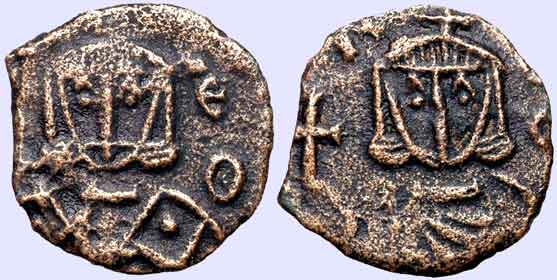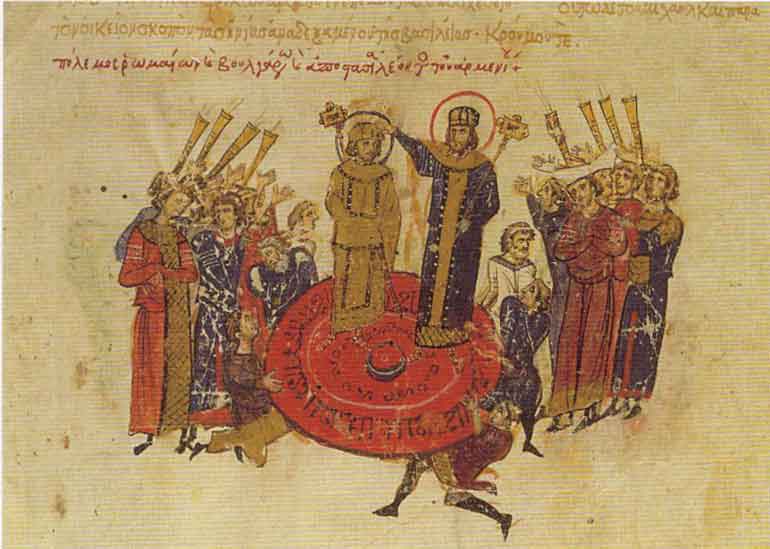.

Contemporary coin of Leo V.
Leo V the Armenian (Greek: Λέων Ε΄, Leōn V), (775 – December 25, 820), was emperor of the Byzantine Empire from 813 to 820.
Life
Leo was the son of the patrician Bardas, who was of Armenian descent. Leo served in 803 under the rebel general Bardanes Tourkos, whom he deserted in favor of Emperor Nikephoros I. The emperor rewarded Leo with two palaces, but later exiled him for marrying the daughter of another rebel, the patrician Arsaber. Recalled by Michael I Rangabe in 811, Leo became governor of the Anatolic theme and conducted himself well in a war against the Arabs in 812. Leo survived the Battle of Versinikia in 813 by abandoning the battlefield, but nevertheless took advantage of this defeat to force the abdication of Michael I in his favor on July 11, 813.
With Krum of Bulgaria blockading Constantinople by land, Leo V had inherited a precarious situation. He offered to negotiate in person with the invader and attempted to have him killed in an ambush. The stratagem failed, and although Krum abandoned his siege of the capital, he captured and depopulated Adrianople and Arkadioupolis (Lüleburgaz). When Krum died in spring 814, Leo V defeated the Bulgarians in the environs of Mesembria (Nesebar) and the two states concluded a 30-year peace in 815.

Michael I on a shield with Leo V
With the iconodule policy of his predecessors associated with defeats at the hands of Bulgarians and Arabs, Leo V reinstituted Iconoclasm after deposing Patriarch Nikephoros and convoking a synod at Constantinople in 815. The emperor used his iconoclast policy to seize the properties of iconodules and monasteries, such as the rich Stoudios monastery, whose influential iconodula abbot, Theodore the Studite, he exiled.
Leo V appointed competent military commanders from among his own comrades-in-arms, including Michael the Amorian and Thomas the Slav. He also persecuted the Paulicians. When Leo jailed Michael for suspicion of conspiracy, the latter escaped from prison and organized the assassination of the emperor in the cathedral Hagia Sophia on Christmas, 820. Leo was praying alone before the altar, with his guards standing outside the church. The conspirators were disguised as priests and monks lead by Michael who had been set free by his partisans only hours before entered the church. When they approached Leo they drew their daggers to stab him. Leo, suspecting something was wrong, jumped away when he saw the daggers and tried to flee and call for his guards, but the doors were locked and his guards were slain by the conspirators. Unarmed, Leo tried to defend himself with a large wooden cross in one hand and an incense burner with the other, attacking Michael and his followers. This battle lasted for an hour and finally Leo succumbed to the wounds inflicted upon him. Michael was immediately proclaimed Emperor on the spot still wearing the chains from the prison in his hands.
Family
By his wife Theodosia, a daughter of the patrician Arsaber, Leo V had several children, including:
- Symbatios, renamed Constantine, co-emperor from 814 to 820.
Preceded by: Michael I
Succeeded by: Michael II
| Ancient Greece
Science, Technology , Medicine , Warfare, , Biographies , Life , Cities/Places/Maps , Arts , Literature , Philosophy ,Olympics, Mythology , History , Images Medieval Greece / Byzantine Empire Science, Technology, Arts, , Warfare , Literature, Biographies, Icons, History Modern Greece Cities, Islands, Regions, Fauna/Flora ,Biographies , History , Warfare, Science/Technology, Literature, Music , Arts , Film/Actors , Sport , Fashion --- |
Retrieved from "http://en.wikipedia.org"
All text is available under the terms of the GNU Free Documentation License

